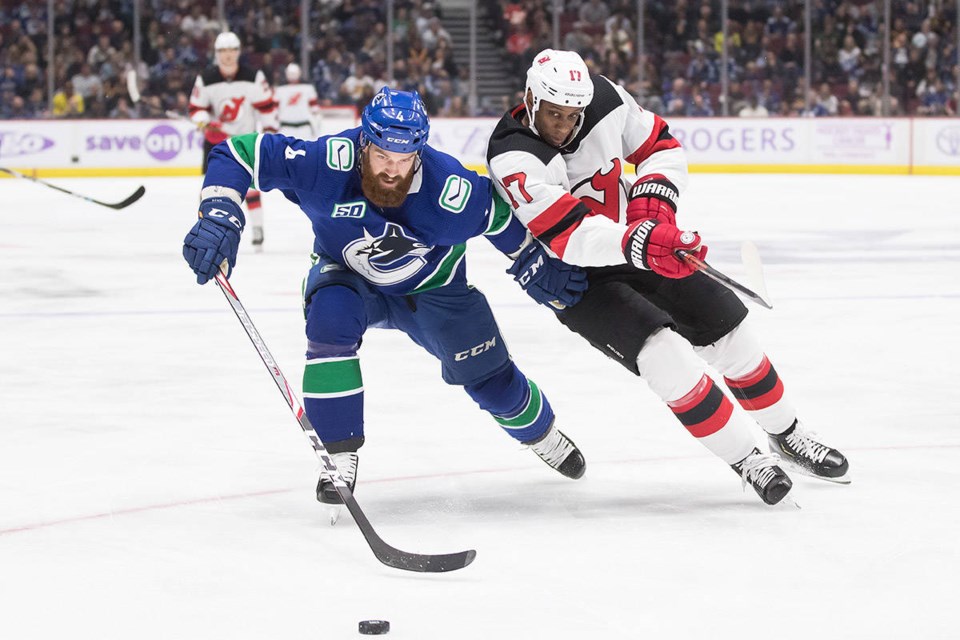The Canucks find themselves in an unusual position heading into the 2020 trade deadline: they’re buyers.
The last four seasons, the Canucks have been in a position to be sellers at the trade deadline, whether they’ve actually done any selling or not. Now, with just over two weeks until the deadline, they’re first place in the Pacific Division and fourth in the Western Conference, prime position to add a player for a potential playoff run.
There are a few hurdles for the Canucks to overcome, however. One is that they’re very close to the salary cap, with limited options for clearing space. Most players that they could fit into that cap space likely wouldn’t be much of an upgrade on the current roster.
They can create a little bit more room by waiving a player with a big contract and sending them down to the AHL, but that can only free up a maximum of $1.075 million with the rules for buried contracts.
The other option is to move out a contract in a trade, either by trading a player with an equivalent contract the other way or making a separate deal. The trouble is, moving money for money means adding assets: sending a big contract out could cost the Canucks a significant prospect and/or a pick.
Another issue is that the Canucks have limited assets with which to make a trade. Their prospect pool is better than it was, but not so deep that the Canucks can dip into it at will to improve their current lineup. With their first round pick for the next two drafts in limbo because of the trade for J.T. Miller, they likely don’t have a first round pick in play at the deadline — not that they should be looking to trade away another first round pick.
Let’s assume, for the moment, that the Canucks can navigate those issues. They’re certainly not insurmountable obstacles and if the Canucks have the will to add at the trade deadline, they should be able to find a way.
With that in mind, who should the Canucks be targeting? And who should they avoid entirely? Let’s take a look at some of their areas of need.
1 | The left-side defenceman
The Canucks made big changes to their defence during the off-season, adding Tyler Myers, Jordie Benn, and Oscar Fantenberg in free agency. Benn was meant to shore up the third pairing and provide insurance in case of an injury in the top-four, but he has struggled so far this season, dragging down his usual defence partner, Troy Stecher, in the process.
Perhaps the reports out of Montreal that he’s better on the right side were accurate.
Fantenberg has stepped into the lineup in place of Benn, but his pairing with Tyler Myers has been disastrous at times: they regularly struggle to defend the blue line on zone entries and frequently get hemmed in the defensive zone, unable to move the puck out with possession.
That leaves the Canucks in the awkward position of needing to upgrade a position they already overhauled in the off-season. Who should they look to acquire?
Yes: Brenden Dillon
The San Jose Sharks weren't supposed to be in this position this year. They're in the NHL basement without a first-round pick in the upcoming draft.
Dillon has been the reliable defensive presence anchoring pairings with the Sharks’ freewheeling offensive defencemen, Brent Burns and Erik Karlsson. He’s a defensive defenceman in the vein of Chris Tanev: his own offensive impact is minimal, but he is excellent at preventing scoring chances. He’s also stepped into more penalty minutes this season than in past years.
You can see his impact in the defensive zone (and lack thereof in the offensive zone) via his isolated heatmap from HockeyViz.
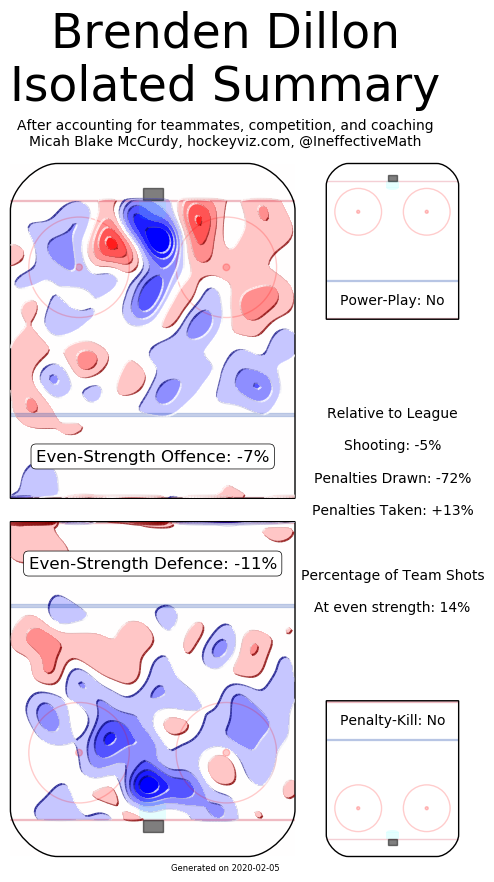 Brenden Dillon Isolated Impact from HockeyViz.com.
Brenden Dillon Isolated Impact from HockeyViz.com.If the Canucks are looking for a defenceman that can regularly chip in offensively, Dillon wouldn’t be the player to target, but if they want someone defensively reliable to play behind Quinn Hughes and Alex Edler on the left side, Dillon is a safe bet.
Dillon is in the final year of a $3.27 million per year contract, meaning a trade would need salary retained, money moving the other way, or some combination of the two, but it’s doable. Pierre LeBrun has speculated that the price for Dillon could be a second-round pick “and maybe a prospect.”
No: Alec Martinez
The Los Angeles Kings’ defenceman has a lot going for him: Martinez is a two-time Stanley Cup Champion, even scoring the Cup-winning goal in double overtime in 2014. Since then, Martinez has grown into a bigger role with the Kings, to the point that he’s now on the top pairing with Drew Doughty, averaging over 21 minutes per game for five-straight seasons.
Martinez even has another year on his $4 million contract, making him attractive for teams looking for more than just a rental. That more expensive price tag compared to Dillon, even if it’s a small difference, could make it more difficult for a team like the Canucks to fit Martinez, however.
The bigger issue with Martinez is that he’s on the wrong side of 30 and appears to be losing a step from his best years. If the Canucks are looking for a reliable third-pairing guy, Martinez just doesn’t make sense: his defensive impact is significantly negative. Perhaps with less pressure on a bottom pairing, he’d do better, but that’s not a risk I would recommend.
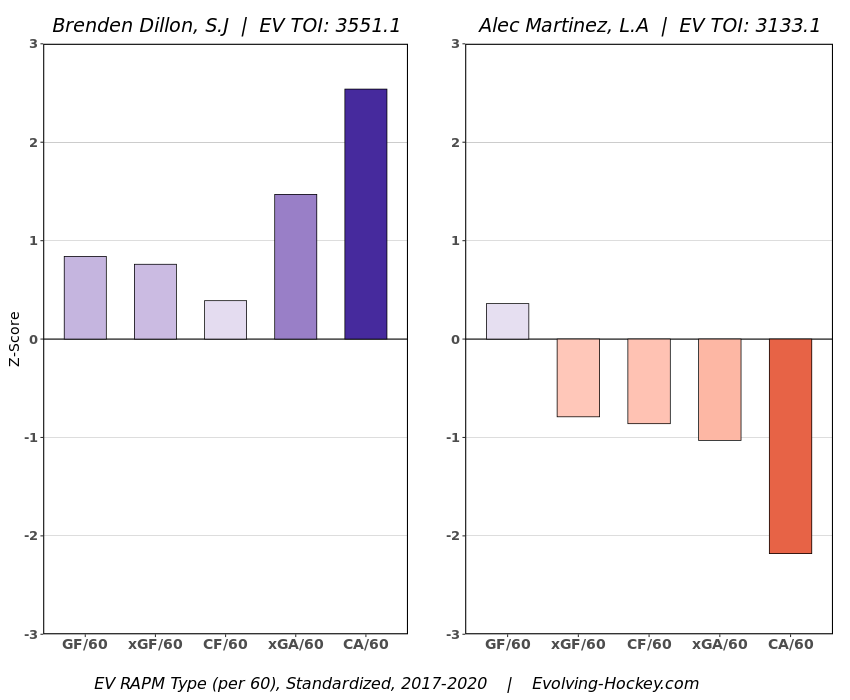 Brenden Dillon vs Alec Martinez RAPM Chart from Evolving-Hockey.com.
Brenden Dillon vs Alec Martinez RAPM Chart from Evolving-Hockey.com.Comparing Martinez to Dillon at 5-on-5 using Regularized Adjusted Plus Minus from Evolving Hockey, we can see that over the last three seasons, Dillon has been massively better than Martinez defensively — the right two bars — and above average offensively as well. Martinez doesn’t provide the offence and his defensive game has fallen off.
That means the extra year on his contract is an anchor, rather than an advantage.
2 | The top-six winger for Bo Horvat
As much as Loui Eriksson has experienced a renaissance in Vancouver over the last couple months and has actually been a decent fit on Bo Horvat’s wing, the Canucks could definitely use an upgrade that might provide a little more scoring punch.
Heading into the season, that was expected to be J.T. Miller, but he instead found a home alongside Elias Pettersson. Meanwhile, Micheal Ferland fell down the lineup before suffering a concussion. In any case, his defensive miscues make him a poor fit with the tough matchups the Horvat line regularly faces.
That means the Canucks have very specific requirements when looking for top-six help, narrowing the field a fair amount.
Yes: Ondrej Kase
A bit of an analytics darling, the 24-year-old Kase significantly moves the needle when it comes to puck possession, but the points don’t always follow the way it seems they should. Kase has 7 goals and 22 points in 48 games this season, but his impact on the game goes well beyond his point totals.
His isolated heat map from HockeyViz shows the type of impact he has on the game, with his team producing dangerous scoring chances when he’s on the ice and limiting the quality of chances against.
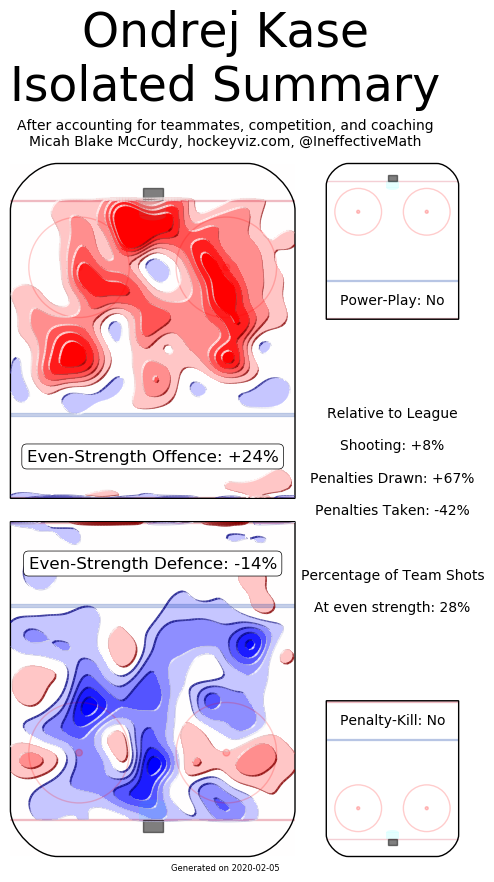 Ondrej Kase Isolated Impact from HockeyViz.com.
Ondrej Kase Isolated Impact from HockeyViz.com.That’s the type of player that would be a great fit alongside Bo Horvat on a matchup line and he would represent a clear upgrade on Eriksson.
Additionally, Kase is signed through next season to a very reasonable $2.6 million per year contract and will be a restricted free agent when it expires. That would make a Kase trade a deal not just for the current season, but for the future as well.
The question for the Canucks, then, will be cost. Are they willing to move a promising prospect for Kase, who has had injury issues in his career? The time is right to acquire Kase, as his goals and points are down from the last couple years: if the Canucks can buy low, Kase could be a steal, as his scoring should pick up.
No: Wayne Simmonds
The Canucks have expressed interest in Simmonds according to Pierre LeBrun. They reportedly tried to sign Simmonds during the summer, but he chose to stay in the Eastern Conference, and the Canucks turned instead to Micheal Ferland.
Simmonds, who is a pending UFA, was once a legitimate first-line forward, topping the 30-goal mark in two seasons and coming close in three more. He earned a reputation as a power forward with his willingness to drive to the net, throw hits, and drop the gloves. It’s understandable why Jim Benning, who targeted grittier top-six forwards this past off-season, would be interested in Simmonds.
There are a couple big reasons why the Canucks should avoid Simmonds, however. One is his $5 million cap hit. Even if the New Jersey Devils retain salary, that’s a tough number to fit into the Canucks’ cap situation.
The biggest reason the Canucks should avoid Simmonds, however, is that he’s just not as good as he used to be. If the Canucks look to acquire him to be a top-six forward, they’re bound to be disappointed. His even-strength offence is nearly non-existent and he doesn’t provide as much as he used to on the power play.
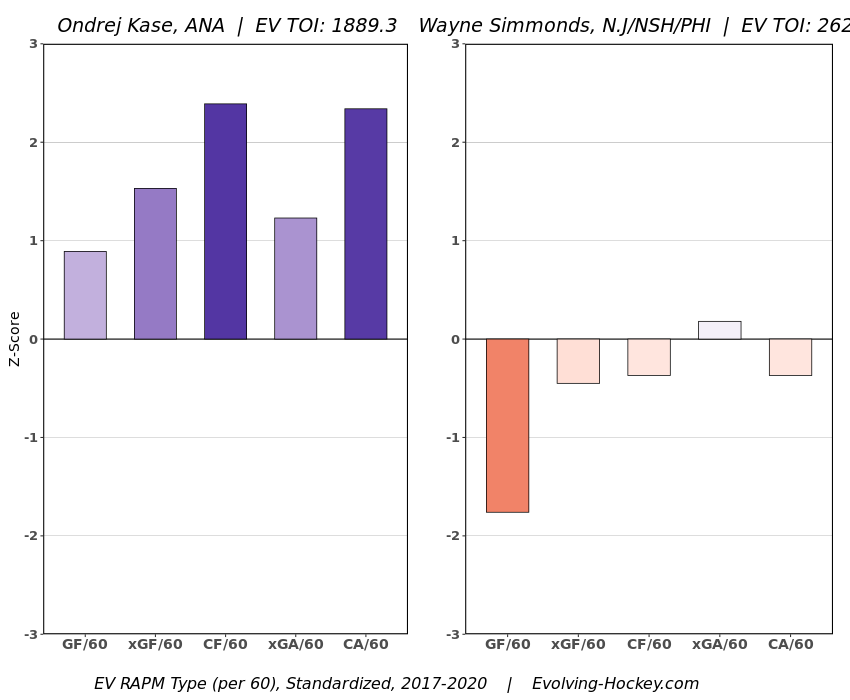 Ondrej Kase vs Wayne Simmonds RAPM Chart from Evolving-Hockey.com.
Ondrej Kase vs Wayne Simmonds RAPM Chart from Evolving-Hockey.com.Would Simmonds be an upgrade in the bottom-six? Sure, but not a significant enough one to be worth the price the Canucks would surely have to pay.
3 | The bottom-six upgrade
The Canucks are currently spending $9.275 million on their fourth line of Tim Schaller, Jay Beagle, and Brandon Sutter. That’s not ideal. Making it worse, however, is that the line gets absolutely crushed in terms of puck possession and scoring chances when they’re on the ice, even when you take into account their defensively-skewed usage.
So, despite the money spent on bottom-six grit and penalty killing, the Canucks could legitimately use an upgrade. Perhaps they could find a player to replace Tim Schaller or someone to skate with Adam Gaudette, pushing Antoine Roussel to the fourth line, at least until injuries necessitate moving up the lineup.
Who might fit?
Yes: Marcus Foligno
The Canucks got a faceful of Foligno on Thursday, as the big forward made a big impact on the game, throwing some big hits and dropping the gloves with Zach MacEwen. That likely got the attention of Jim Benning, not to mention Canucks fans that bemoaned the lack of response from the team when Elias Pettersson took a late hit from Matt Grzelcyk of the Boston Bruins.
The thing that sets Foligno apart from some other big bruisers is that he has a significantly positive impact on the game in between the whistles. A hard-working, physical forward, Foligno contributes significantly on the defensive end of the ice, preventing high-quality scoring chances, as seen in his isolated heatmap from HockeyViz.
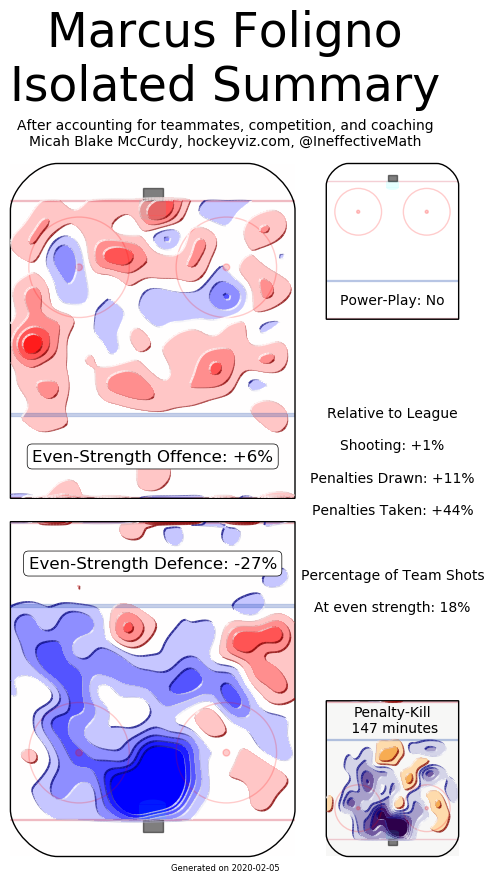 Marcus Foligno Isolated Impact from HockeyViz.com.
Marcus Foligno Isolated Impact from HockeyViz.com.Foligno is also second among Wild forwards in ice time on the penalty kill and he has a positive impact there as well.
Beyond his defensive game, Foligno provides some decent offence in a depth role: he has consistently put up 20+ points per season and has already reached 20 points this season, on-pace for a career year.
That latter point means the price to acquire Foligno might be a little higher, but his $2.875 million cap hit is pretty palatable for such an impactful bottom-six forward. He’s signed through 2021, so he’s not just a rental, though the Canucks would have to make some tough decisions in the off-season.
If the Canucks do want to add some grit, they should look for a player like Foligno, who has a significant impact beyond his grittiness.
No: Melker Karlsson
Then there’s the Sharks’ lesser Karlsson, who has minimal impact anywhere on the ice. The issue with Karlsson isn’t that he’s bad, really, just that he doesn’t move the needle in any significant way.
Karlsson is decent enough defensively and can kill penalties, but provides very little offensively. In that way, he’s a lot like several players the Canucks already have on the roster. Adding another very similar player, especially one like Karlsson that doesn’t provide other elements like grit and toughness, just doesn’t make much sense.
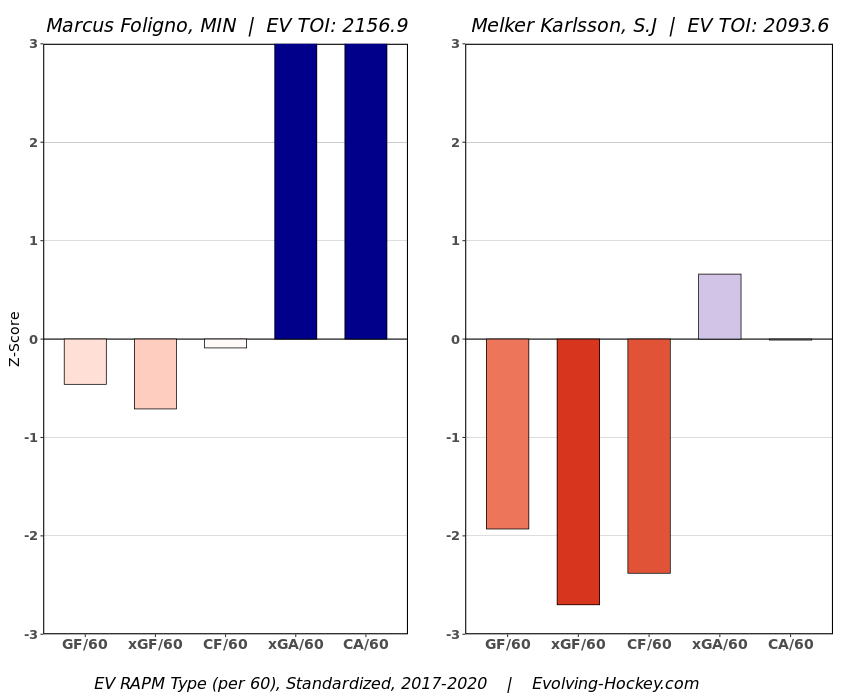 Marcus Foligno vs Melker Karlsson RAPM Chart from Evolving-Hockey.com.
Marcus Foligno vs Melker Karlsson RAPM Chart from Evolving-Hockey.com.Karlsson is cheaper than Foligno, therefore easier to fit under the cap for the Canucks, but if the Canucks want to actually significantly improve their bottom-six, they have find something other than more-of-the-same.
While the Canucks will have little maneuverability under the cap heading into the trade deadline, there are moves they can make to improve the roster for the push to the playoffs. What they need to avoid, however, is adding players that sound like they fit a need, but don't actually provide an upgrade.
There are other players the Canucks could target and plenty more that they should avoid; these six players provide a framework for helping to decide which players would make the most sense.
